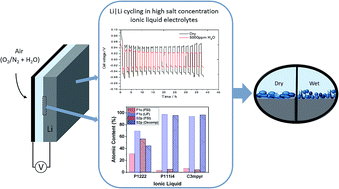当前位置:
X-MOL 学术
›
Sustain. Energy Fuels
›
论文详情
Our official English website, www.x-mol.net, welcomes your
feedback! (Note: you will need to create a separate account there.)
Water-tolerant lithium metal cycling in high lithium concentration phosphonium-based ionic liquid electrolytes†
Sustainable Energy & Fuels ( IF 5.0 ) Pub Date : 2018-08-03 00:00:00 , DOI: 10.1039/c8se00159f Robert Kerr 1, 2, 3 , Nikhilendra Singh 4, 5, 6 , Timothy S. Arthur 4, 5, 6 , Thushan Pathirana 1, 2, 3 , Fuminori Mizuno 4, 5, 6 , Kensuke Takechi 4, 5, 6 , Maria Forsyth 1, 2, 3 , Patrick C. Howlett 1, 2, 3
Sustainable Energy & Fuels ( IF 5.0 ) Pub Date : 2018-08-03 00:00:00 , DOI: 10.1039/c8se00159f Robert Kerr 1, 2, 3 , Nikhilendra Singh 4, 5, 6 , Timothy S. Arthur 4, 5, 6 , Thushan Pathirana 1, 2, 3 , Fuminori Mizuno 4, 5, 6 , Kensuke Takechi 4, 5, 6 , Maria Forsyth 1, 2, 3 , Patrick C. Howlett 1, 2, 3
Affiliation

|
Cycling stability at high capacities and water-tolerance are two key properties for the operation of high-capacity lithium (Li) metal–air batteries. Here, we have demonstrated the cycling of Li metal at high rates and high capacities in a newly developed family of ionic liquids based on quaternary alkylphosphonium cations and the bis(fluorosulfonyl)imide anion. A high LiFSI salt concentration of 50 mol% gave the most favourable combination of performance and water-tolerance when compared to 33 mol% and 20 mol%. These high salt content electrolytes exhibited stable cycling at 1 mA cm−2, in 1 h steps for up to 250 cycles at room temperature in the presence of up to 5000 ppm water. The two smallest cations, triethylmethylphosphonium (P1222) and trimethylisobutylphosphonium (P111i4), showed significantly superior cycling capabilities than the larger tributylmethylphosphonium (P1444) and trihexyltetradecylphosphonium (P66614) cations. Furthermore, the two small phosphonium cations supported high current densities and more stable long-term cycling than the N-methyl-N-propylpyrrolidinium cation (C3mpyr), which is of similar molecular weight. Fourier transform infra-red spectroscopy was used to characterise the composition of electrode surface layers, while ex situ X-ray photoelectron spectroscopy showed that the presence of water affects the amount of decomposition products at the electrode surface. These benchmark cycling results represent a significant step forward in the development of water-tolerant electrolytes for Li metal-based batteries.
中文翻译:

高锂浓度phospho基离子液体电解质中的耐水锂金属循环†
高容量循环稳定性和耐水性是高容量锂(Li)金属-空气电池运行的两个关键特性。在这里,我们已经证明了基于季烷基phosph阳离子和双(氟磺酰基)酰亚胺阴离子的新型离子液体家族中锂金属的高速率和高容量循环。与33 mol%和20 mol%相比,高LiFSI盐浓度为50 mol%提供了性能和耐水性的最佳组合。这些高盐含量的电解质在1mA厘米表现出稳定的循环-2,在长达250个循环在室温下在向上的存在至5000ppm水1层小时的步骤。最小的两个阳离子,三乙基甲基phosph(P 1222)和三甲基异丁基phosph(P111i4)表现出比较大的三丁基甲基phosph(P 1444)和三己基十四烷基phosph(P 66614)阳离子明显更好的循环能力。此外,与分子量相似的N-甲基-N-丙基吡咯烷鎓阳离子(C 3 mpyr)相比,这两个小的small阳离子具有高电流密度和更稳定的长期循环。傅里叶变换红外光谱用于表征电极表面层的组成,而非原位X射线光电子能谱显示水的存在影响电极表面上分解产物的量。这些基准循环结果代表了在锂金属基电池的耐水电解质开发方面迈出的重要一步。
更新日期:2018-08-03
中文翻译:

高锂浓度phospho基离子液体电解质中的耐水锂金属循环†
高容量循环稳定性和耐水性是高容量锂(Li)金属-空气电池运行的两个关键特性。在这里,我们已经证明了基于季烷基phosph阳离子和双(氟磺酰基)酰亚胺阴离子的新型离子液体家族中锂金属的高速率和高容量循环。与33 mol%和20 mol%相比,高LiFSI盐浓度为50 mol%提供了性能和耐水性的最佳组合。这些高盐含量的电解质在1mA厘米表现出稳定的循环-2,在长达250个循环在室温下在向上的存在至5000ppm水1层小时的步骤。最小的两个阳离子,三乙基甲基phosph(P 1222)和三甲基异丁基phosph(P111i4)表现出比较大的三丁基甲基phosph(P 1444)和三己基十四烷基phosph(P 66614)阳离子明显更好的循环能力。此外,与分子量相似的N-甲基-N-丙基吡咯烷鎓阳离子(C 3 mpyr)相比,这两个小的small阳离子具有高电流密度和更稳定的长期循环。傅里叶变换红外光谱用于表征电极表面层的组成,而非原位X射线光电子能谱显示水的存在影响电极表面上分解产物的量。这些基准循环结果代表了在锂金属基电池的耐水电解质开发方面迈出的重要一步。











































 京公网安备 11010802027423号
京公网安备 11010802027423号